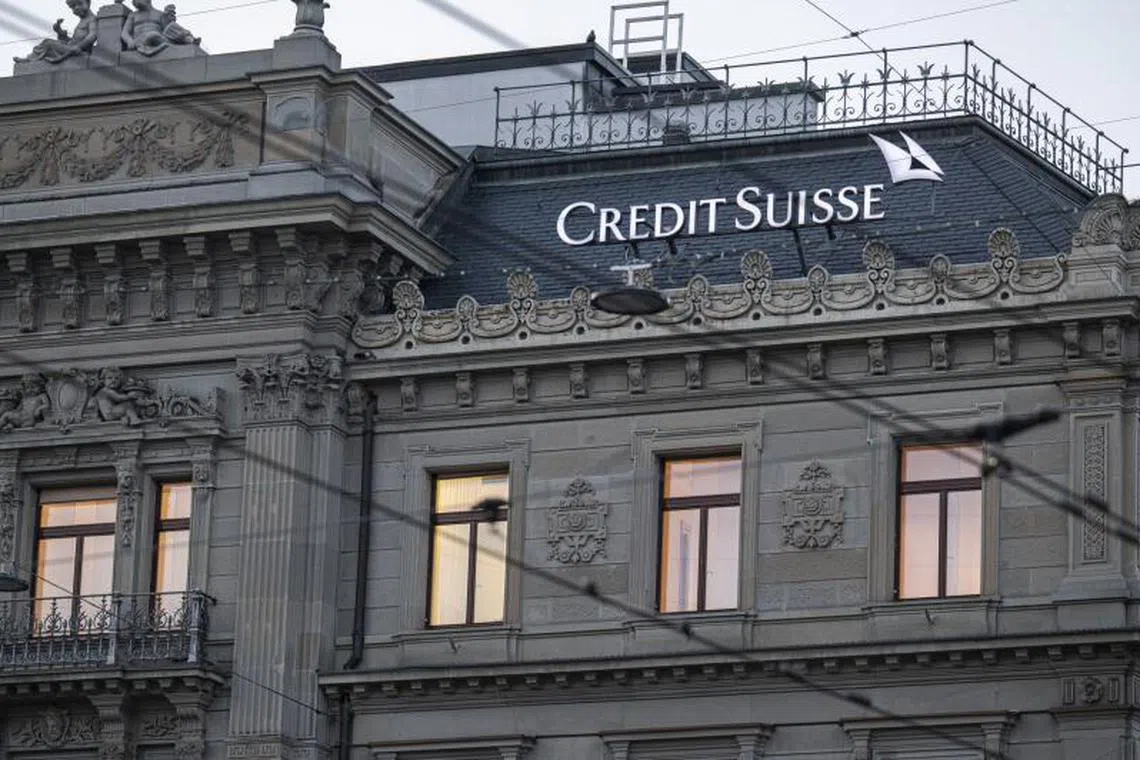Credit Suisse in crisis: What went wrong?
Sign up now: Get ST's newsletters delivered to your inbox

The Swiss banks has been plagued by scandals, public legal battles and mounting losses.
PHOTO: BLOOMBERG
Follow topic:
Zurich - Switzerland’s role as banker to the world’s rich is built on a reputation for institutional discretion and dull reliability. That only makes the scandals, public legal battles and mounting losses at Credit Suisse more striking and hard to comprehend.
In mid-March, unease about the bank’s mounting problems snowballed and its shares slumped, forcing management to appeal to the Swiss banking authorities for a public vote of confidence.
1. What went wrong?
Credit Suisse’s failings have included a criminal conviction for allowing drug dealers to launder money in Bulgaria,
Its association with disgraced financier Lex Greensill and failed US-based investment company Archegos Capital Management compounded the sense of an institution that did not have a firm grip on its affairs.
Many fed-up clients have voted with their feet, leading to unprecedented client outflows in late 2022.
2. What triggered the latest share slump?
Chief executive Ulrich Koerner launched a massive outreach to woo back nervous clients and their cash. The effort appeared to be paying off by January, when it reported “net positive” deposits.
However, on March 9, the US Securities and Exchange Commission queried the bank’s annual report, forcing it to delay its publication.
Panic spread after regional US lender Silicon Valley Bank (SVB) failed,
Investors began ditching anything that smelled of banking risk and deposit flight.
3. How bad did the situation get?
On Wednesday, Credit Suisse stock slumped anew when the chairman of its largest shareholder, Saudi National Bank, ruled out investing any more in the company.
This prompted Credit Suisse to ask the Swiss central bank for a public statement of support.
The cost of insuring the bank’s bonds against default for one year surged to levels not seen for major international banks since the financial crisis of 2008.
As other banks sought to hedge their counter-party risk for transactions with Credit Suisse, quoted prices for a one-year credit default swap jumped from 836 basis points, indicating a probability of defaulting of 10 per cent, on Tuesday to higher than 3,000 basis points.
Few actual trades were executed, however, as liquidity in the market dried up.
In another sign of stress, Credit Suisse’s additional Tier 1 bonds – which are subordinate to all other ranks of debt and may be written down if capital falls below a predetermined level – were trading below 80 per cent of face value, a level typically signalling distress.
Even bonds coming due in April traded at prices well below face value.
4. Is this another Lehman Brothers moment?
The Wall Street giant, whose failure in 2008 triggered the global financial crisis, succumbed when funding dried up and other banks stopped dealing with it.
Unlike Lehman and SVB, Credit Suisse has substantial liquid assets to call upon and access to central bank lending facilities, and is less sensitive than many rivals to sharp moves in interest rates. It has rebuilt its cushion against more deposit withdrawals since the worst wave of outflows last October.
It also has enough money-like liquid assets to pay back half of all its liabilities in deposits and loans from other banks, according to Bloomberg Opinion banking columnist Paul J. Davies.
Credit Suisse’s Mr Koerner said the bank’s liquidity coverage ratio showed it can handle over a month of heavy outflows in a period of stress.
On Thursday, after securing a 50 billion Swiss franc (S$73 billion) lifeline from the Swiss National Bank (SNB), Credit Suisse shares bounced back, soaring by at least 30 per cent in pre-market trading.
5. What else is Credit Suisse doing to turn things around?
Mr Koerner’s three-year recovery plan involves 9,000 job cuts, dismantling the investment banking behemoth assembled over five decades and returning Credit Suisse to its origins as banker to the world’s ultra-wealthy.
That means spinning off First Boston, an American investment bank it acquired in 1990 with a view to listing it in 2025, and selling parts of its securitised products unit to Apollo Global Management.
That process is now at risk of becoming bogged down in a broader financial sector sell-off following the collapse of SVB and two other United States banks.
6. What services does Credit Suisse provide in Singapore and what should investors here do?
Singapore is part of Credit Suisse’s Asia-Pacific business. The Straits Times understands that the bank no longer discloses figures on the Asia-Pacific as a division as well as country-specific breakdowns.
Credit Suisse offers wealth management, investment banking and capital markets, and asset management services in the Asia-Pacific and Singapore.
Credit Suisse Singapore did not respond to follow-up queries by press time.
OCBC Bank head of wealth advisory Aaron Chwee noted that the SNB loan provided to Credit Suisse will provide short-term relief for markets, but said investors will be looking for longer-term solutions to Credit Suisse’s problems.
“This uncertainty will likely result in elevated volatility within the US and European financial sectors over the next few days and maybe weeks,” he wrote in a statement on Thursday.
Mr Chwee said investors concerned about the volatility can consider buying more high-quality bonds or units trusts that offer similar exposure.
Meanwhile, investors with a long-term view can consider looking at good-quality equities whose share prices have fallen. BLOOMBERG
Additional reporting by Kang Wan Chern

